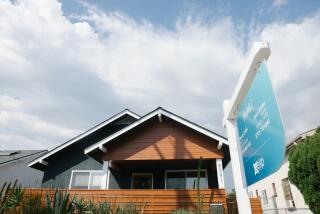New-Home Sales Jump 9%; Best Rate in a Year
- Share via
WASHINGTON — Warmed by rising temperatures and falling interest rates, Americans bought new single-family homes in March at the fastest rate in more than a year, the federal government reported Monday.
The 9% February-to-March jump in new-home sales translated to 698,000 individual sales on a seasonally adjusted annual basis, the Commerce Department and the Department of Housing and Urban Development said. That was the best since the 700,000-unit rate in February, 1984, and bettered the 677,000-unit rate in March, 1984.
A separate report last week showed sales of existing single-family homes at the highest level in more than four years.
Housing activity is a key factor in measuring the strength of the economy as a whole; as post-recession growth has slowed, a lessening of demand for credit has allowed interest rates to drop, and that, in turn, has fueled faster growth in the housing industry.
The Federal Home Loan Bank Board has said that the average interest on new-home mortgages fell to 11.91% in March from 12.21% in February and that the rate for previously occupied homes fell to 12.18% from 12.39%.
Another part of Monday’s report contained further good news for builders: The supply of unsold homes at current sales rates would last only 6.4 months, the lowest figure in six months. That should portend strength in housing starts in the weeks ahead, with a resultant boost to the economy because of the ripple effect that flows from housing construction.
Indeed, a report Monday by the F. W. Dodge division of McGraw-Hill Information Systems said the value of contracts for new construction rose a seasonally adjusted 12% in March from the previous month to an annual rate of $227.7 billion.
With both single-family and multifamily building advancing, it was the first time in almost a year that the rate of total residential building exceeded $100 billion, the report said. Residential building rose the most, by 19%, to $112.5 billion last month.
“A spurt of apartment building by itself would not be conclusive, but March’s added support in the credit-sensitive, one-family home market confirms that last year’s housing decline has been turned around,” said George A. Christie, chief economist for Dodge.
The report said the value of non-residential building contracts rose 4% to $76.4 billion. Non-building construction contracts--for public works and utilities--rose 7% to $38.9 billion. These contracts were dominated by a sharp rise in highway construction, while most other categories showed declines, Dodge said.
Industry analysts were buoyed though not surprised by the government’s report.
Robert Spiller, president of the Mortgage Bankers Assn. of America, said the increase was due largely to moderating interest rates.
“We’re also looking at the fact that the weather is getting warmer,” he said. “People are coming out of their cocoons and looking and saying they want to buy a house.”
Jack Carlson, chief executive of the National Assn. of Realtors, noted that the rise in new-home sales coincides with a 5.9% increase in sales of existing single-family homes as reported by his organization last week.
Carlson said the two reports “demonstrate the strong demand for housing and the benefits of lower mortgage interest rates.” He said that each one-point decline in interest rates means that about 500,000 additional families can afford to buy a house because of lower monthly payments.
Regionally, the sharpest jump in sales was a 21% gain in the West. Home sales went up 9% in the South and 7% in the Midwest but declined 8% in the Northeast.
More to Read
Inside the business of entertainment
The Wide Shot brings you news, analysis and insights on everything from streaming wars to production — and what it all means for the future.
You may occasionally receive promotional content from the Los Angeles Times.










